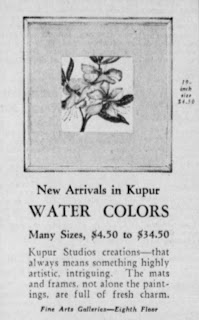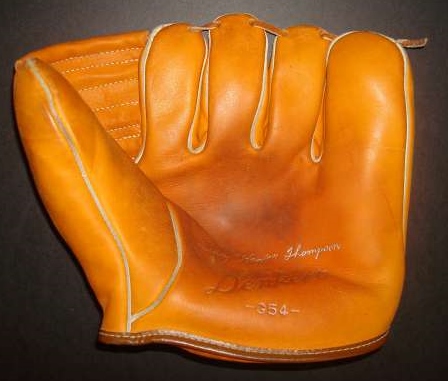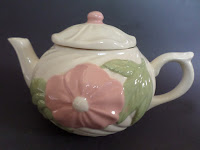LAMPS -WATERCOLORS - STATUES SIGNED KUPUR
If you have a Lamp, Watercolor (Gouache), Bookends or Statue signed Kupur, I can give you it's origin. Artist/Sculptor Frederick Cooper opened a studio in Chicago in 1923 specializing in Watercolors and Statues. At some point thereafter, he began producing lamps made from the sculptures/statues he was creating. This aspect of the business eventually took over most of his operation. In 1945, Cooper retired and sold the business, which kept his namesake. It turns out that as recently as the 1990's, Frederick Cooper Studios still controlled the trademark name "Kupur".
All of the water colors, lamps and statues that I have seen signed "Kupur" are similar is signature style and are on works from approximately the 1930's-1950's. Most often a hyphen (-) is at the beginning and end of the signature. It is of my opinion that once Cooper retired, the "Kupur" line and signatures eventually were phased out while the company went on to have some success in the lamp making industry over the next 60 years. If you have a piece signed "Kupur" it is from The Frederick Cooper Studios and was either done by Cooper himself or an employee of the studio.
I have added 1937-1938 Detroit Free Press ads from J.L. Hudson's Fine Arts Galleries. This ad is for Watercolors from "Kupur Studios"
I have added photos of 3 newspaper ads from 1943-1946 from 3 different Home Furnishing Stores that advertise "Kuper" Watercolors. All are from the Midwest. The one from Milliken's is great as it shows a typical example of a floral subject. The one from Jenkins & Co. basically confirms "Kupur" water colors as being a product by putting quotations around the name. Walper Furniture Co. mentions several "famous" artists which includes Kupur. The use of the word famous was very liberal. Elmer Greene's works favored heavy on still life floral themes and were mainly produced and currently found as lithographs. Rieman and Massig were Chicago area artists that sold their works through the House of Baldwin Home Furnishings store at the Merchandise Mart in Chicago.
Kupur Watercolors, Lamps and Statues are not by a virtually unknown Russian itinerant artist named Ruben Kupur. It is lazy research that took hold because he is the only artist that happened to be listed anywhere with the name Kupur.
Home furnishing stores of the magnitude shown here were not selling high end, original art, but, rather were looking to find commercially available product that fit the current trends of the time. A studio such as Cooper's could provide such product as could the House of Baldwin.
The Frederick Cooper Studio hired artists to manufacture (and yes, paint) their products, which included lamps, water colors and statues.
 A very nice reader has sent me a photo of a lamp that had an original tag from Frederick Cooper Studios mentioning their "KUPUR" line. The inside info mentions "for over 25 years" which would fit in the timeline that Cooper opened his studio and the approximate date that this lamp was manufactured. It also would have been after Cooper retired which I think was the beginning of the end of "Kupur" signed pieces. This lamp is not signed.
A very nice reader has sent me a photo of a lamp that had an original tag from Frederick Cooper Studios mentioning their "KUPUR" line. The inside info mentions "for over 25 years" which would fit in the timeline that Cooper opened his studio and the approximate date that this lamp was manufactured. It also would have been after Cooper retired which I think was the beginning of the end of "Kupur" signed pieces. This lamp is not signed.


1943 ads looking for employees
All of the water colors, lamps and statues that I have seen signed "Kupur" are similar is signature style and are on works from approximately the 1930's-1950's. Most often a hyphen (-) is at the beginning and end of the signature. It is of my opinion that once Cooper retired, the "Kupur" line and signatures eventually were phased out while the company went on to have some success in the lamp making industry over the next 60 years. If you have a piece signed "Kupur" it is from The Frederick Cooper Studios and was either done by Cooper himself or an employee of the studio.
I have added 1937-1938 Detroit Free Press ads from J.L. Hudson's Fine Arts Galleries. This ad is for Watercolors from "Kupur Studios"
I have added photos of 3 newspaper ads from 1943-1946 from 3 different Home Furnishing Stores that advertise "Kuper" Watercolors. All are from the Midwest. The one from Milliken's is great as it shows a typical example of a floral subject. The one from Jenkins & Co. basically confirms "Kupur" water colors as being a product by putting quotations around the name. Walper Furniture Co. mentions several "famous" artists which includes Kupur. The use of the word famous was very liberal. Elmer Greene's works favored heavy on still life floral themes and were mainly produced and currently found as lithographs. Rieman and Massig were Chicago area artists that sold their works through the House of Baldwin Home Furnishings store at the Merchandise Mart in Chicago.
Kupur Watercolors, Lamps and Statues are not by a virtually unknown Russian itinerant artist named Ruben Kupur. It is lazy research that took hold because he is the only artist that happened to be listed anywhere with the name Kupur.
Home furnishing stores of the magnitude shown here were not selling high end, original art, but, rather were looking to find commercially available product that fit the current trends of the time. A studio such as Cooper's could provide such product as could the House of Baldwin.
The Frederick Cooper Studio hired artists to manufacture (and yes, paint) their products, which included lamps, water colors and statues.
 A very nice reader has sent me a photo of a lamp that had an original tag from Frederick Cooper Studios mentioning their "KUPUR" line. The inside info mentions "for over 25 years" which would fit in the timeline that Cooper opened his studio and the approximate date that this lamp was manufactured. It also would have been after Cooper retired which I think was the beginning of the end of "Kupur" signed pieces. This lamp is not signed.
A very nice reader has sent me a photo of a lamp that had an original tag from Frederick Cooper Studios mentioning their "KUPUR" line. The inside info mentions "for over 25 years" which would fit in the timeline that Cooper opened his studio and the approximate date that this lamp was manufactured. It also would have been after Cooper retired which I think was the beginning of the end of "Kupur" signed pieces. This lamp is not signed.

1943 ads looking for employees









Comments
That said, I do appreciate the efforts.
What I have on Kupur is:
Ruben Kupur was born in Russia in 1887. He emigrated to America in 1907. He was likely an itinerant artist who worked mostly around the Midwest. His painted works are typically found in pairs. I have a WPA-style painted set hanging in my living room that look decidedly Russian. He also did some sculptures (figures and lamps). His painted works are always signed "-Kupur-" in the same hand.
Maybe this info will help someone?
It is a beautiful picture!
Cover: This is a Kupur lamp
Frederick Cooper Studios
Inside: KUPUR LAMPS For over 25 years "Kupur" line has been known for its originality in design and craftsmanship.
Kupur lamps and shades are individually designed by creative artists specializing in correlating contemporary and period ensembles.
Visualize this Kupur Lamp and Shade...It will blend with your requisite for individuality.
Ask to see other hand crafted Kupur Lamps and Shades.
Frederick Cooper Studios
Chicago 15. Illinois
Back: (hand written) 38.00 lamp and shade
Style No. 81232
I just wish I had the original shade for this lamp
I have several Kupur watercolors as well and the signatures are all similar
Carl B.
The artist was either Frederick Cooper or one of his staff.
I currently have a lamp with k u p u r signed on it I believe it is a work of the Russian artist how do I find out and authenticate this. And if it's true about the Cooper artist are either of these lamps whatever may be true about them worth any money and considered antique
- A real person named Kupur who was a Russian immigrant to Chicago. The paintings I own are clearly Russian influenced.
- Kupur as an alternate brand name for Cooper. Not named for a person.
I wonder if Cooper lamps may have been founded by an immigrant named Kupur who Americanized their name upon arrival. Then later reused their name, Kupur, for an alternate brand under Cooper lamps.
https://frederickcooper.com/aboutus.htm